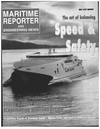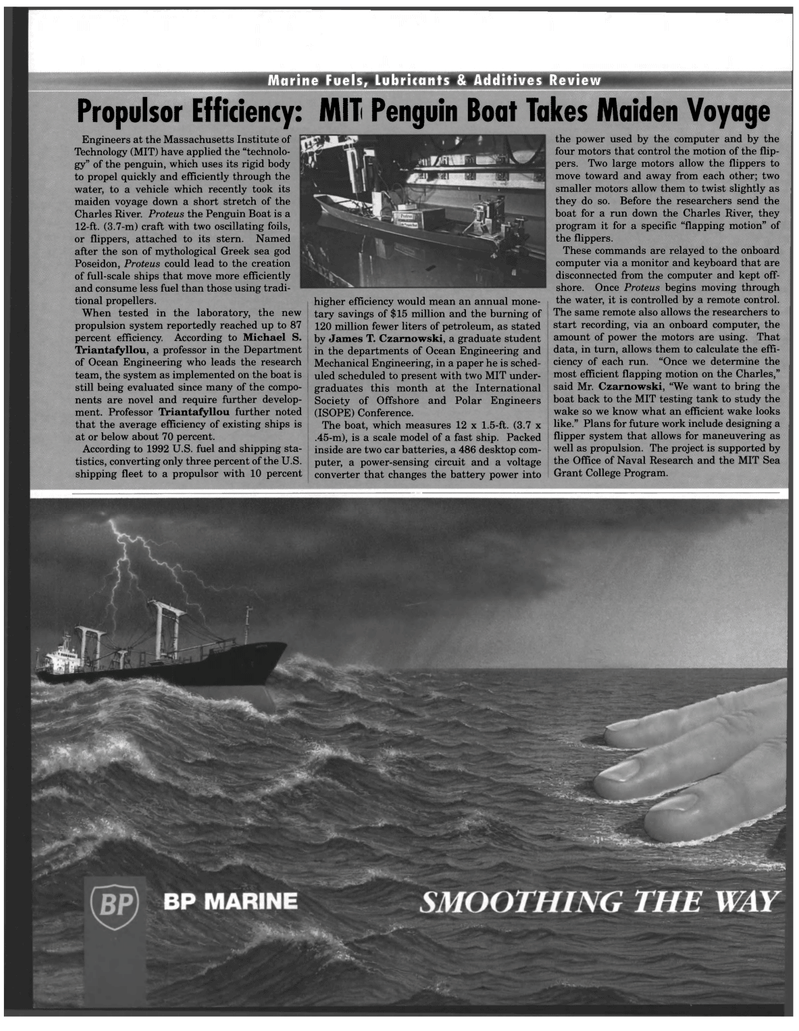
Page 66: of Maritime Reporter Magazine (May 1997)
Read this page in Pdf, Flash or Html5 edition of May 1997 Maritime Reporter Magazine
Marine Fuels, Lubricants & Additives Review •
Propulsor Efficiency: MIT Penguin Boat Takes Maiden Voyage higher efficiency would mean an annual mone- tary savings of $15 million and the burning of 120 million fewer liters of petroleum, as stated by James T. Czarnowski, a graduate student in the departments of Ocean Engineering and
Mechanical Engineering, in a paper he is sched- uled scheduled to present with two MIT under- graduates this month at the International
Society of Offshore and Polar Engineers (ISOPE) Conference.
The boat, which measures 12 x 1.5-ft. (3.7 x .45-m), is a scale model of a fast ship. Packed inside are two car batteries, a 486 desktop com- puter, a power-sensing circuit and a voltage converter that changes the battery power into the power used by the computer and by the four motors that control the motion of the flip- pers. Two large motors allow the flippers to move toward and away from each other; two smaller motors allow them to twist slightly as they do so. Before the researchers send the boat for a run down the Charles River, they program it for a specific "flapping motion" of the flippers.
These commands are relayed to the onboard computer via a monitor and keyboard that are disconnected from the computer and kept off- shore. Once Proteus begins moving through the water, it is controlled by a remote control.
The same remote also allows the researchers to start recording, via an onboard computer, the amount of power the motors are using. That data, in turn, allows them to calculate the effi- ciency of each run. "Once we determine the most efficient flapping motion on the Charles," said Mr. Czarnowski, "We want to bring the boat back to the MIT testing tank to study the wake so we know what an efficient wake looks like." Plans for future work include designing a flipper system that allows for maneuvering as well as propulsion. The project is supported by the Office of Naval Research and the MIT Sea
Grant College Program.
Engineers at the Massachusetts Institute of
Technology (MIT) have applied the "technolo- gy" of the penguin, which uses its rigid body to propel quickly and efficiently through the water, to a vehicle which recently took its maiden voyage down a short stretch of the
Charles River. Proteus the Penguin Boat is a 12-ft. (3.7-m) craft with two oscillating foils, or flippers, attached to its stern. Named after the son of mythological Greek sea god
Poseidon, Proteus could lead to the creation of full-scale ships that move more efficiently and consume less fuel than those using tradi- tional propellers.
When tested in the laboratory, the new propulsion system reportedly reached up to 87 percent efficiency. According to Michael S.
Triantafyllou, a professor in the Department of Ocean Engineering who leads the research team, the system as implemented on the boat is still being evaluated since many of the compo- nents are novel and require further develop- ment. Professor Triantafyllou further noted that the average efficiency of existing ships is at or below about 70 percent.
According to 1992 U.S. fuel and shipping sta- tistics, converting only three percent of the U.S. shipping fleet to a propulsor with 10 percent

 65
65

 67
67
